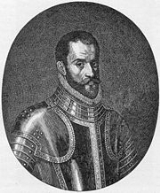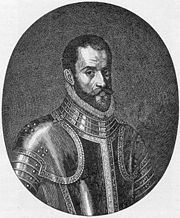
Pontus De la Gardie
Encyclopedia

Pontus De la Gardie was a French
French people
The French are a nation that share a common French culture and speak the French language as a mother tongue. Historically, the French population are descended from peoples of Celtic, Latin and Germanic origin, and are today a mixture of several ethnic groups...
nobleman
Nobility
Nobility is a social class which possesses more acknowledged privileges or eminence than members of most other classes in a society, membership therein typically being hereditary. The privileges associated with nobility may constitute substantial advantages over or relative to non-nobles, or may be...
and general in the service of Denmark
Denmark
Denmark is a Scandinavian country in Northern Europe. The countries of Denmark and Greenland, as well as the Faroe Islands, constitute the Kingdom of Denmark . It is the southernmost of the Nordic countries, southwest of Sweden and south of Norway, and bordered to the south by Germany. Denmark...
and Sweden
Sweden
Sweden , officially the Kingdom of Sweden , is a Nordic country on the Scandinavian Peninsula in Northern Europe. Sweden borders with Norway and Finland and is connected to Denmark by a bridge-tunnel across the Öresund....
.
He was born Ponce De La Gardie in Russol (Aude
Aude
Aude is a department in south-central France named after the river Aude. The local council also calls the department "Cathar Country".Aude is also a frequent feminine French given name in Francophone countries, deriving initially from Aude or Oda, a wife of Bertrand, Duke of Aquitaine, and mother...
), Languedoc
Languedoc
Languedoc is a former province of France, now continued in the modern-day régions of Languedoc-Roussillon and Midi-Pyrénées in the south of France, and whose capital city was Toulouse, now in Midi-Pyrénées. It had an area of approximately 42,700 km² .-Geographical Extent:The traditional...
, as a son of Jacques De la Gardie and Catherine de Sainte-Colombe. As a youngster, he wanted to become a priest and was educated in a monastery
Monastery
Monastery denotes the building, or complex of buildings, that houses a room reserved for prayer as well as the domestic quarters and workplace of monastics, whether monks or nuns, and whether living in community or alone .Monasteries may vary greatly in size – a small dwelling accommodating only...
. He changed his mind however, and left Languedoc to become a mercenary
Mercenary
A mercenary, is a person who takes part in an armed conflict based on the promise of material compensation rather than having a direct interest in, or a legal obligation to, the conflict itself. A non-conscript professional member of a regular army is not considered to be a mercenary although he...
in the service of Denmark. De la Gardie was promoted to officer and was in charge of a regiment of mercenaries. In 1565, during the Northern Seven Years' War
Northern Seven Years' War
The Northern Seven Years' War was the war between Kingdom of Sweden and a coalition of Denmark–Norway, Lübeck and the Polish–Lithuanian union, fought between 1563 and 1570...
, he was captured by Swedish troops at Varberg
Varberg
Varberg is a locality and the seat of Varberg Municipality, Halland County, Sweden with 26,041 inhabitants in 2005.Varberg and all of Halland are well known for their 'typical west coast' sandy beaches. In Varberg the coast changes from wide sandy beaches to rocky terrain that continues north into...
, and changed allegiance to Sweden. De la Gardie quickly became a favourite of John III of Sweden
John III of Sweden
-Family:John married his first wife, Catherine Jagellonica of Poland , house of Jagiello, in Vilnius on 4 October 1562. In Sweden, she is known as Katarina Jagellonica. She was the sister of king Sigismund II Augustus of Poland...
and in 1569, after only four years in the Swedish service, he received noble status. In 1571, he was created a baron and was given Ekholmen Castle.
After Clas Åkesson Tott
Clas Åkesson Tott
Clas Åkesson Tott was a military Field Marshal and member of the Privy Council of Sweden .In the Russo-Swedish War , he was the rittmeister of the cavalry squadron Upplandsfanan. He became responsible for the enlistment of army personnel in Finland, in 1563...
's resignation as the supreme commander of the Swedish forces in Finland
Finland
Finland , officially the Republic of Finland, is a Nordic country situated in the Fennoscandian region of Northern Europe. It is bordered by Sweden in the west, Norway in the north and Russia in the east, while Estonia lies to its south across the Gulf of Finland.Around 5.4 million people reside...
and Estonia
Estonia
Estonia , officially the Republic of Estonia , is a state in the Baltic region of Northern Europe. It is bordered to the north by the Gulf of Finland, to the west by the Baltic Sea, to the south by Latvia , and to the east by Lake Peipsi and the Russian Federation . Across the Baltic Sea lies...
as a consequence of the Siege of Wesenberg (1574)
Siege of Wesenberg (1574)
The Siege of Wesenberg was an abortive Swedish siege of the Russian-held town of Wesenberg in Estonia from January through March 1574, during the Livonian War. The siege is infamous for a brawl and subsequent combat between German and Scottish mercenaries within the besieging army, which claimed...
during the Livonian War
Livonian War
The Livonian War was fought for control of Old Livonia in the territory of present-day Estonia and Latvia when the Tsardom of Russia faced a varying coalition of Denmark–Norway, the Kingdom of Sweden, the Union of the Grand Duchy of Lithuania and the Kingdom of Poland.During the period 1558–1578,...
, de la Gardie took over Tott's office. De la Gardie's skills combined with the fact that Sweden's enemy Russia had to transfer troops to defend against Polish attacks further south led to considerable military success for Sweden during the following years. In the fall of 1580, Karelia
Karelia
Karelia , the land of the Karelian peoples, is an area in Northern Europe of historical significance for Finland, Russia, and Sweden...
was conquered. De la Gardie led his troops over the frozen Gulf of Finland
Gulf of Finland
The Gulf of Finland is the easternmost arm of the Baltic Sea. It extends between Finland and Estonia all the way to Saint Petersburg in Russia, where the river Neva drains into it. Other major cities around the gulf include Helsinki and Tallinn...
to capture the fortresses of Wesenberg
Wesenberg
Wesenberg may refer to:*The German name for Rakvere, a town in Estonia*Wesenberg, Mecklenburg-Vorpommern, part of the Amt Mecklenburgische Kleinseenplatte, Mecklenburg-Western Pomerania, Germany...
(Rakvere) and Tolsburg (Toolse). In September 1581, Narva was taken after a storming that had been preceded by a massive bombardment. 4,000 soldiers and civilians were killed, pointing out the fact that De la Gardie was not only a skillful warrior, but a cruel and hard commander as well. De la Gardie and his Swedish troops went on to capture the fortress of Ivangorod
Ivangorod
Ivangorod is a town in Leningrad Oblast, Russia, situated on the right bank of the Narva River by the Russian-Estonian border, west of St. Petersburg. Population: The town is known for the Ivangorod fortress....
and several other fortresses that autumn. In 1582, the war with Russia was ended and Sweden got to keep the conquests made in Karelia and Ingria
Ingria
Ingria is a historical region in the eastern Baltic, now part of Russia, comprising the southern bank of the river Neva, between the Gulf of Finland, the Narva River, Lake Peipus in the west, and Lake Ladoga and the western bank of the Volkhov river in the east...
, but had to withdraw from Livonia.
De la Gardie was the most renowned military commander in Sweden during the 16th century and has been credited with much of the country's military success in the 1580s. An example of his ingenuity was the strategy of using zigzag shaped saps
Sapping
Mining, landmining or undermining is a siege method which has been used since antiquity against a walled city, fortress, castle or other strongly held and fortified military position.-Antiquity:...
during the siege of Narva, a new technique at the time.
De la Gardie drowned in the Narva River
Narva River
The Narva is a river flowing into the Baltic Sea, the largest river in Estonia. Draining Lake Peipsi, the river forms the border of Estonia and Russia and flows through the towns of Narva/Ivangorod and Narva-Jõesuu into Narva Bay. Though the river is only 77 km long, in terms of volume...
and is buried in St Mary's Cathedral of Tallinn
St Mary's cathedral of Tallinn
St Mary's Cathedral, Tallinn is a church located on Toompea Hill in Tallinn, Estonia. Originally established by Danes on 13th century, it is the oldest church in Tallinn and mainland Estonia...
. His tomb chest is made by well-known artist and architect Arent Passer
Arent Passer
Arent Passer was a stonemason and architect of the Netherlands origin. He was born in Hague and worked in Tallinn from 1589 until his death. Arent Passer is buried in St...
.
Family
4 February 1580 De la Gardie married Sofia Johansdotter GyllenhielmSofia Johansdotter Gyllenhielm
Sofia Johansdotter Gyllenhielm in Reval, Estonia, was a Swedish noble. She was the illegitimate daughter of King John III of Sweden and Karin Hansdotter....
(ca.1556-1583), the illegitimate daughter of John III of Sweden
John III of Sweden
-Family:John married his first wife, Catherine Jagellonica of Poland , house of Jagiello, in Vilnius on 4 October 1562. In Sweden, she is known as Katarina Jagellonica. She was the sister of king Sigismund II Augustus of Poland...
and the Finnish society lady Karin Hansdotter
Karin Hansdotter
Karin Hansdotter was the royal mistress of King John III of Sweden in the 1550s before his marriage during his time as Prince and Duke of Finland.- Biography :...
. During the wedding act, a gallery in the church broke and one person was killed. Some sceptics claimed it was a bad omen or a divine act with which God condemned the marriage.
Pontus De la Gardie and Sofia Gyllenhielm had three children:
- Brita De la Gardie (Pontusdotter) (1581–1645)
- FreiherrFreiherrThe German titles Freiherr and Freifrau and Freiin are titles of nobility, used preceding a person's given name or, after 1919, before the surname...
Johan De la Gardie (1582–1642), was a statesmanStatesmanA statesman is usually a politician or other notable public figure who has had a long and respected career in politics or government at the national and international level. As a term of respect, it is usually left to supporters or commentators to use the term...
of the Swedish EmpireSwedish EmpireThe Swedish Empire refers to the Kingdom of Sweden between 1561 and 1721 . During this time, Sweden was one of the great European powers. In Swedish, the period is called Stormaktstiden, literally meaning "the Great Power Era"... - CountCountA count or countess is an aristocratic nobleman in European countries. The word count came into English from the French comte, itself from Latin comes—in its accusative comitem—meaning "companion", and later "companion of the emperor, delegate of the emperor". The adjective form of the word is...
and Field MarshalField MarshalField Marshal is a military rank. Traditionally, it is the highest military rank in an army.-Etymology:The origin of the rank of field marshal dates to the early Middle Ages, originally meaning the keeper of the king's horses , from the time of the early Frankish kings.-Usage and hierarchical...
Jacob De la GardieJacob De la GardieField Marshal and Count Jacob Pontusson De la Gardie was a statesman and a soldier of the Swedish Empire....
(1583–1652), was a significant military leader

